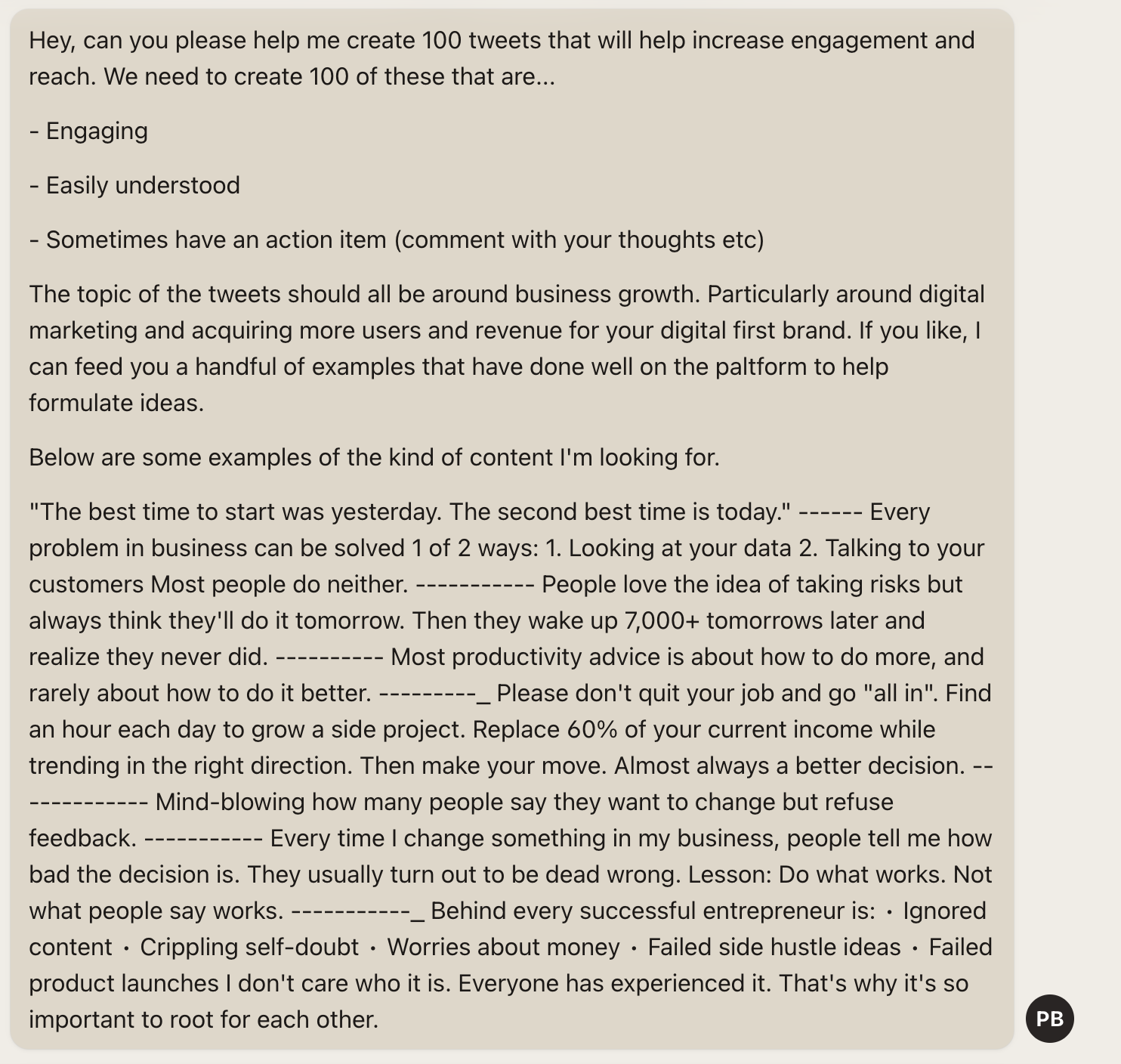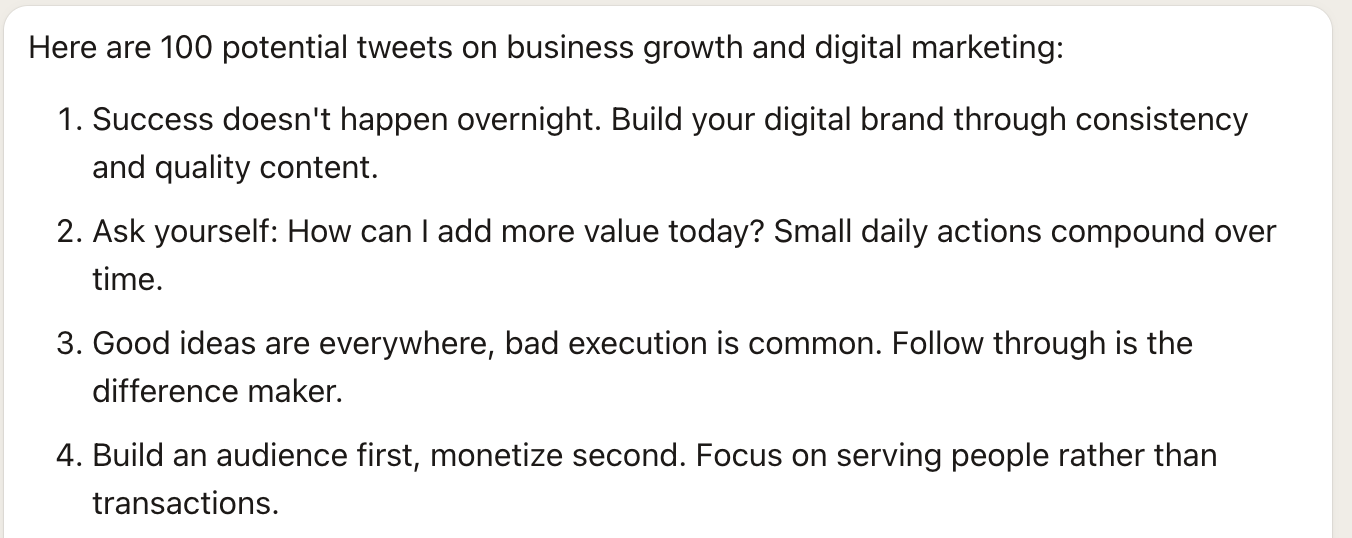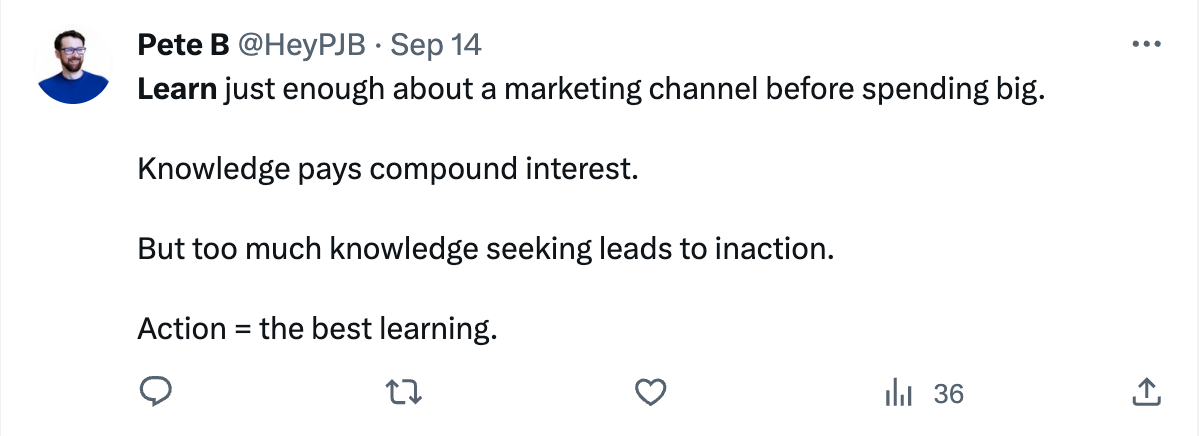There’s nothing worse than slaving over a detailed, long-form social media post for a few hours only to see it get a few likes.
And then, when you check your feed, there’s some influencer who’s shared a 2 sentence soundbite that’s got tens of thousands of views, hundreds of likes, and dozens of comments.
Being solidly in the camp of “long-form posts and no engagement” myself, I decided to see if AI could help me improve my social media marketing and online presence.
Here’s what I did, and how it worked.
My AI content marketing strategy from a high-level
As mentioned above, a lot of my social media posts tend to get overlooked and ignored.
However, there are plenty of people out there who have less professional experience than I who have millions of followers.
They know something I don’t, and so I decided to look into what it is that they do and say.
The basic advice is the same across the board.
- Share “useful” content (even if the giver of this advice shares useless content)
- Be consistent
- Share things that get people to engage
- Engage with others
Pretty standard advice.
When I started looking into the kind of posts that people who are known and trusted in social media growth share, I saw them getting a lot of engagement on posts like the below from Justin Welsh.

It’s a short post.
A great little soundbite which is easy for people to like.
As you can see, this particular one has 835 likes, almost 45K views, and 149 comments.
That alone isn’t what I’m interested in. These are vanity metrics really. But what people like Justin do so well is use posts like the above to increase reach, and then use other posts to move traffic to their site.
There, they can capture the email address and nurture the relationship until the customer ready to buy.
I’ve written about this before with Eddie Shleyner and his awesome engagement loop.

I want to move people from social to my owned channels.
I thought that by sharing a couple of posts like Justin’s above, I might be able to increase the audience size on social and, as a result, direct more people to my site.
The plan was simple. Create a few dozen posts that are…
- Quick to consume
- Easy to like
- Are not controversial (meaning everyone can drop a like)
- Snappy little sound bites
… and this would, hopefully, lead to good social growth.
It would help me fill the top of my funnel and help me warm up the algorithms to then push out my posts to more people and get a wider audience and brand visibility.
I’ll go on to explain the exact process I used to test this, but first, let’s go through what your really want to know.
Here’s a look at the results.
The results of my social media marketing AI experiment
OK, so here’s the quick and dirty results.
I had the AI write 90 posts for me, and was sharing one post 3 times per day.
One in the AM, one mid-afternoon, one mid-evening.
The posts were all short soundbite-type posts that seem to do well from an engagement perspective.
And they were shared simultaneously to my Twitter and my LinkedIn.
An example of the posts is below.

Let’s break this down by channel I used.
Twitter results
OK, so the experiment started on September 4th.
Overall, you can see that for the ~30 days after September 4th the posts generated consistent engagement. Nothing huge and no real growth over time.

It’s much more stable engagement than the preceding 30 days. But there’s not the nice upswing in overall engagement I was hoping for.
there are still a few spikes in terms of engagement, but as you can see, I managed to get those from the prior period as well.
Basically, throughout the period it seems to have just raised my daily impression benchmark from 0 to around 100 impressions per day.
Here’s the interesting bit on Twitter though.
The preceding 30-day period the average daily impressions was 275. That’s when not sharing some content on days at all. This is skewed by the large spikes here and there thought.

During the experiment, the daily impressions were lower at only 170.

That’s a 38% drop in reach.
And, funnily enough, the spikes here are from posts that I shared that were not AI written.
The 26th is the big spike where I wrote something about Google’s HCU.

As for followers, in both August and September I lost the same number of followers each month. Which is odd.

But reach and follower numbers aren’t everything.
I use social to drive traffic to my own sites so I can convert them to paying customers.
So let’s run a quick breakdown of the 30-day prior period and the 30-day period of the experiment.
| Twitter engagement | 30 day prior | Experiment period | Change % |
|---|---|---|---|
| Engagement rate | 5.2% | 6.1% | 17% |
| Link clicks | 17 | 1 | -94% |
| Retweets without comments | 10 | 90 | 800% |
| Likes | 92 | 86 | -6.52% |
| Replies | 70 | 40 | -42% |
| Net new subs | -7 | -7 | 0% |

Basically, the AI helped get a huge increase in retweets without comments, but didn’t really help in any other area in a meaningful way.
If we look at the % change, they’re overall pretty negative.

And the lack of links in the AI posts meant that driving traffic from it was a no-go.
LinkedIn results
Let’s look at what it did on LinkedIn.
LinkedIn changed the way the algo works just at the start of the experiment, which I think had an impact on how things came out.
they seem to be focusing more on useful content now (which is good). Reach has gone down, but many are reporting that meaningful customer engagements are on the rise.
Overall the impression looked like this.

Again it appears to have raised the bottom baseline of engagement, but had no meaningful impact over time.
There’s no gradual upswing in impressions.
Funnily enough, in the last 90 days my top performing content by impressions (and engagement) are 3 posts that were manually written.

In terms of followers on LinkedIn, that also doesn’t appear to have changed much.

I’ve been through and pulled out the daily stats to compare the 30-day time periods again.
| LinkedIn engagement | Preceding 30 days | Experimentation period | % change |
|---|---|---|---|
| Impressions | 6,460 | 10,190 | 57.74% |
| Engagements | 171 | 229 | 33.92% |
| Followers | 85 | 106 | 24.71 |
On LinkedIn, it was an increase across the board.

And if we again look at the % changes from using AI content, you can see that everything is doing a little better than just manual only posts.

What’s funny is that none of the AI posts were the most viewed or the most engaged with. However, they seem to be enough to get people to engage with my account which then helps them see more of the “value-focused” posts.
A summary of the results and my thoughts
Long story short, the AI content seemed to help increase the daily benchmark of my reach and engagements on social.
It also seems to help warm up the algorithms to me.
You can see this as the posts that still did the best and got the most engagement and views were the pieces I wrote without AI that focused on real issues my audience faces.
I believe this is because the algorithms are slowly filtering out and throttling the reach of low-value posts that could be written by AI.
I mean, it’s called social media. It’s for people to that to one another, not regurgitate thoughts and beliefs they’ve heard a thousand times over.
Twitter saw much wore results with AI content in all meaningful metrics.
However, I actually think that’s because I’m not one of the new Twitter blue people and am not paying to use the platform.
Might have been different had I decided to pay that monthly fee to Elon.
Maybe that’s the focus for another experiment.
Moving forward, I think I will keep using these to grow the baseline engagement from LinkedIn.
I’m already spending more time there as the Twitter algo seems to be off right now. Let’s see how far we can take Linkedin.
If you want to try this yourself, here’s what I did.
The overall approach of using AI to grow my social account
Here’s a quick overview of the process I used to create Ai content for my social accounts.
Why use AI for social media marketing?
Let’s quickly go over why I used AI for social media marketing.
The short version is I thought it might be both fun and instructive.
But also, I’m not particularly skilled at writing those snappy one-liners that seem to do so well in the algorithms.
Long term It’s a skill I should learn, but short term there’s a way for me to test whether or not this works by using AI.
I will say that the process used was not a full 100% reliance on AI. I had it spit out potentials which I then either edited, deleted, or used as is based on my own thoughts and experiences.
Here’s the full process I used.
How I built the social media marketing campaign
I’ve listed the approach that I used to create and schedule these posts below.
Step 1 – Creation of social posts
I’ve used ChatGPT and similar tools frequently in the past few weeks and months.
I’ve noticed that they give better output if you can give them an example of the kind of thing you want them to create.
So, the first step to the whole thing was to go and find a couple of posts from people who get massive social media engagement.
I copy and pasted these into a simple document for myself to refer to when asking the AI to write the post.
With around 10 example posts, I set off to the AI tool.I decided to use Claude.ai as I find this to be a better tool than Chat GPT.
After spinning up a new chat with Claude, created a simple prompt asking it to create 100 Tweets. I also outlined…
- The way they should be written
- The niche and topic for the posts
- The examples I previously found
The prompt ended up looking like the below.

Claude then spat out 100 options for me to use.

I dropped all 100 into a Google Doc for myself to refer to later (which is also available in the downloads here)
Step 2 – Editing the posts
Before scheduling anything I wanted to double-check the posts.
Last thing I need is for an offensive post or opinion that goes against what I stand for to be in there.
I went through all 100 and took one of three actions…
- OK’d the post for publication
- Edited it to be more in line with my beliefs
- Deleted it if there’s no saving it
For example, Claude spat out the below as one of the options.

This is something I fundamentally disagree with.
I think there’s this big focus on becoming an expert before taking action, which only leads to analysis paralysis.
The best experts are experts because they took action before knowing all the ins and outs. They learned by doing.
And that is the fastest way of learning.
So I manually amended the above to…

Aligns with my beliefs far closer than just the AI.
you’ve got to do this else you risk sharing something that’s just plain wrong.
After editing and deleting, I ended up with 90 social posts.
Step 3 – Scheduling the messages
As mentioned above, I did this on Twitter/X and LinkedIn.
Before I actually got to scheduling the posts I had to figure what kind of time split I wanted.
With 90 messages, I decided that a 30-day cycle of 3 posts per day would be a good option.
It should help warm me up to the algorithm by being “consistent” and it should also work as a good feedback loop for me to quickly understand if this was working.
I’m based in the UK and this happened during British Summer Time.
The time split I went with was…
- 10 AM
- 3 PM
- 8 PM

For the scheduling of the actual messages I used 2 tools.
For Twitter, I already had a Typefully account so used that. This enabled me to spend 30 minutes getting everything uploaded and it took it from there.
Typefully also had some good auto features for things like auto-retweeting and other

It was a great little tool and I would recommend it for Twitter.
I didn’t, however, have the Typefully account where I could also share to LinkedIn.
And being the cheap bastard I am, I instead went and used Buffer’s free tier of their tool.
With Buffer’s free tier you get 10 scheduled posts for free.

Just over 3 days with my thrice-a-day posting schedule.
I copy and pasted over my approved messages and saved them as drafts.
Then, every few days I’d jump in and simply click “add to schedule” for them to be added to my pre-determined share times.
Step 4 – Engagement
After that, it was just a case of keeping an eye on the engagement and comments from others.
If someone left a comment, I’d jump in with a simple reply.

I didn’t want to do too much as I wanted to see whether or not the posts could facilitate growth on their own.
But that’s the basic approach I took to this.
What I would do differently with this AI social media marketing approach
The real question is, would I recommend doing this and, if so, what would I recommend doing differently?
First off, I would recommend this for brands and creators.
It takes next to no time to set up and can help maintain a higher base level of engagement on the platform.
Your name will get out in front of people more frequently and you’ll become more of a known entity. That might change as more rules and regulations are brought in by the platforms to combat AI content though.
So be careful.
As for what I would do differently moving forward, it comes down to content types.
I’ve written about content types before, here’s how I see them playing out on social and what I would do with them.

- Attraction Content – Every day 1-3 times
- This is the simple AI content that would be shared 1-3 times per day. Basically to keep you showing up in people’s timelines and not let the algorithm “go cold” on you.
- Buzz content – 1-2 times per week
- One unique piece per week that helps you get in front of the right people. We’re talking stat heavy pieces that spark conversation, mention posts, etc.
- Conversion content – Traffic shaping 1-5 times per week
- 1-5 longer form posts per week that redirect traffic from the social network to my own site. Basically a snippet of something and a “go here to learn more” in the comments.
- Trust content – Every day for 30 mins
- 30 minutes per day adding valuable comments to other relevant accounts’ posts to build reach and trust.
All in all, that might look something like this.

And in addition, I would focus that attention on one social platform. For me, it’ll be LinkedIn as I dislike Twitter/X and get no results there.
And then the focus is not on growing on that platform, but on moving people towards my wider growth marketing funnel.
If you want to know what I mean by that, check out our Growth Model Audit here.
